Table of Contents
- Introduction
- Editor’s Choice
- Organ Transplantation Statistics – Key Facts
- Organ Transplantation Statistics by Organ Type
- Patients Waiting List for Transplantation by Organ
- Patients Waiting List for Transplantation by Age
- Patients Waiting List for Transplantation by Ethnicity
- Organ Transplantation Statistics – Success Rate
- Organ Transplantation Statistics by Country
- Recent Developments
- Conclusion
- FAQs
Introduction
Organ Transplantation Statistics: Organ transplantation is a medical procedure that involves replacing a damaged or failing organ with a healthy organ from a deceased or living donor.
It is a lifesaving treatment option for individuals with end-stage organ failure or certain debilitating conditions.
Organ Transplantation Statistics By Organs Types
- Kidneys
- Liver
- Heart
- Lungs
- Pancreas
- Intestines
Editor’s Choice
- The Tissue And Organ Transplantation Market Size is projected to reach approximately USD 44 billion by 2033, showing significant growth from the 2023 figure of USD 17.7 billion.
- According to the World Health Organization (WHO), around 135,000 organ transplants are performed annually worldwide.
- Every donor can save 8 lives and enhance over 75 more.
- More than 42,000 organ transplants were performed in 2022.
- 17 people die each day waiting for an organ transplant.
- 104,234 Number of men, women, and children on the national transplant waiting list.
- About 14,890 transplants are done in the year 2023.
- In 2023, 103,822 people need lifesaving organ transplants.
- The number of living donors fell by 58% to 444, accounting for 27% of the total number of organ donors.
- 4,256 patients were waiting for a transplant at the end of March 2021, with a further 5,307 temporarily suspended from transplant lists.
(Source: organdonor, UNOS, NHS)
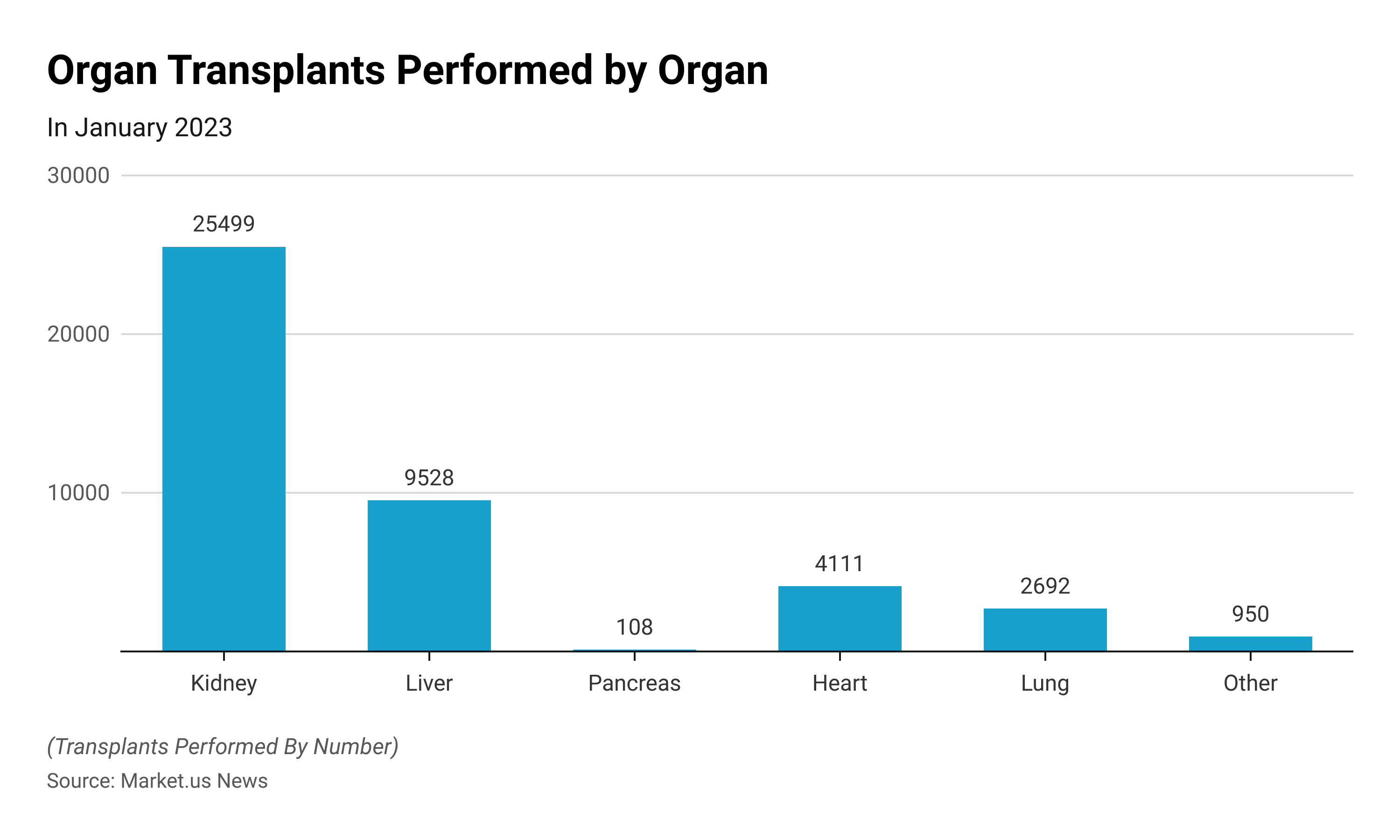
Organ Transplantation Statistics – Key Facts
- There are currently 121,678 individuals waiting in the U.S. for lifesaving organ transplants; 100,791 need kidney transplants alone.
- The median waiting time for an individual’s first kidney transplant is 3.6 years and can vary depending on health, compatibility, and availability of organs.
- In 2023, a total of 7,380 individuals generously became organ donors, with both deceased and living donors.
- The US has reached a historic milestone in organ transplantation: 1 million transplants, more than any other country in the world.
- More than 100,000 people are waiting for lifesaving organ transplants.
- 1 out of 3 decreased donors is over the age of 50.
- In 2022, about 21,300 donors brought new life to recipients and their families.
- The majority of Americans-95% are in favor of organ donation. But only 58% are registered.
- In 2021, the United States had the highest rate of deceased organ donors among select OECD countries with almost 42 people per million population.
- Organ donations globally reached almost 130 thousand in the year 2020.
- The kidney is the most transplanted organ worldwide followed by the liver and the heart. In 2021, there were a total of around 144,302 organ transplants worldwide.
(Source: National Kidney Foundation, UNOS, Donate Life America, donornetworkwest, Statista)
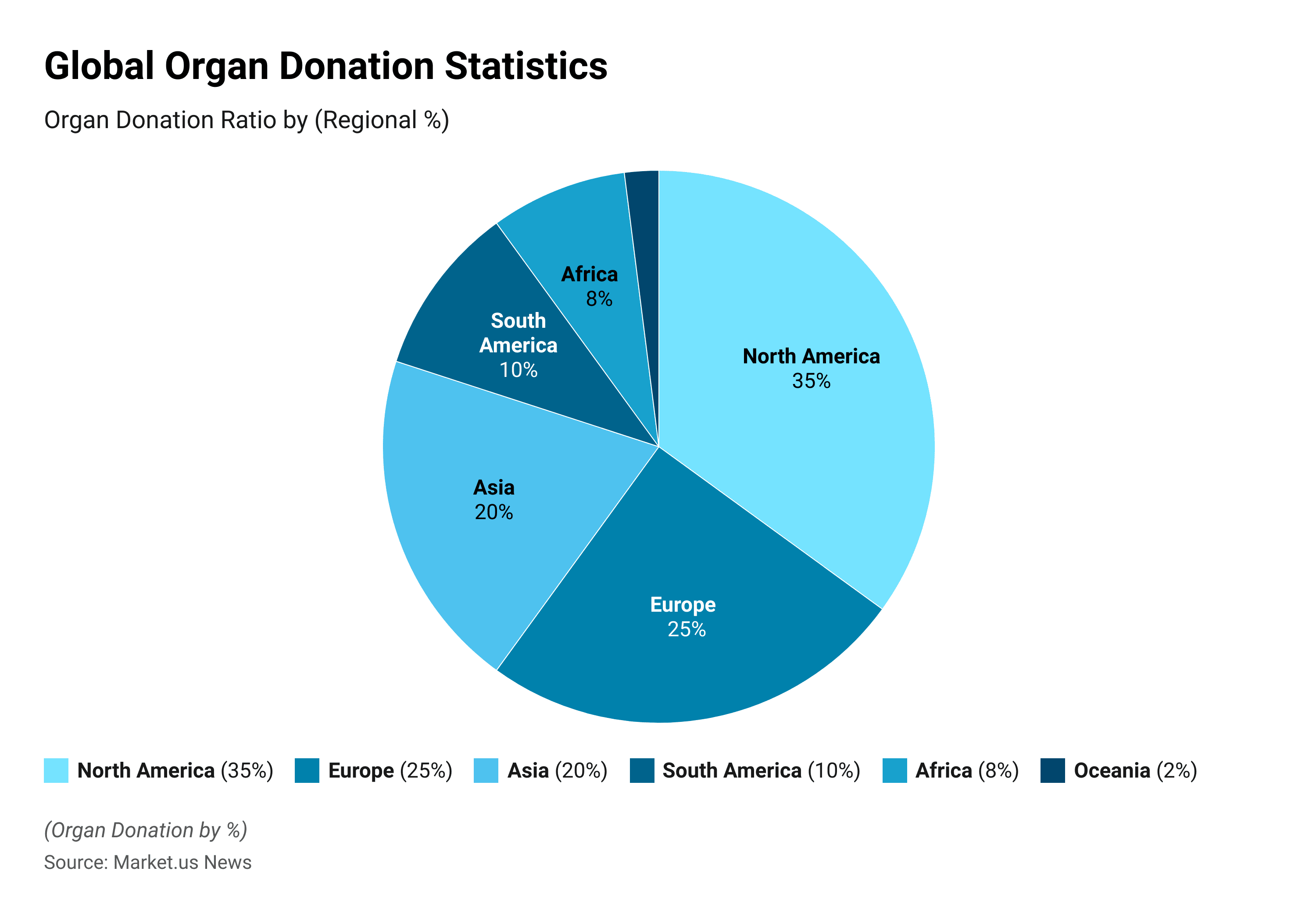
Organ Transplantation Statistics by Organ Type
Liver Transplantation
- In general, about 75% of people who undergo liver transplants live for at least five years.
- About 8,000 liver transplant surgeries are performed in the United States every year.
- In 2020, despite the COVID-19 pandemic, 8906 liver transplants were performed in the United States, more than in any previous year.
- In 2020, 119 programs performed adult liver transplants, and the median transplant program volume increased from 55 in 2019.
- In 2020, 502 pediatric liver transplants were performed in the United States.
- 86% of patients who undergo liver transplantation are still alive 1 year after surgery.
- After 3 years, the survival rate remains high, with 78% of patients alive.
- After 5 years of surgery, the survival rate decreased slightly to 72%.
- In the long term, 20 years of surgery the survival rate further decreased to 53%.
- About 12,790 liver transplants were done in America in 2021.
(Source: Mayo Clinic, HRSA, medicalnewstoday, Statista)
Number of Total Liver Transplants, by Region
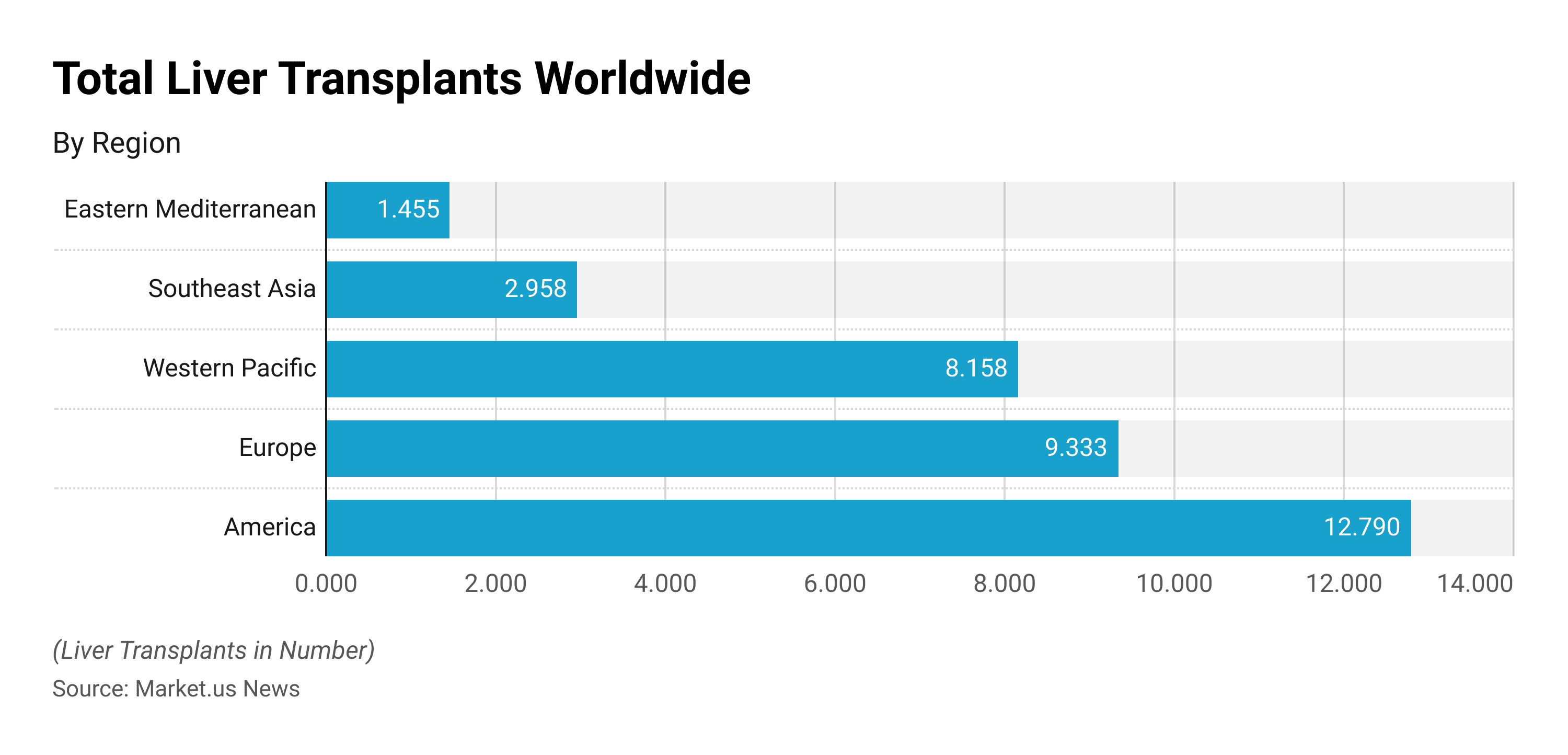
Kidney Transplantation – Organ Transplantation Statistics
- Currently, approximately 7500 kidney transplantations are performed at 250 kidney transplant centers in India.
- Over 3,000 new patients are added to the kidney waiting list each month.
- About 85% of patients are waiting for kidney transplantation.
- 3-5 years is the average waiting time for a kidney from a deceased donor.
- More than 90,000 people in the United States are waiting for kidney donation.
- About 36,232 kidney transplants were done in America in 2021.
(Source: NIH, donate life, Statista)
Kidney Transplants Worldwide, by Region
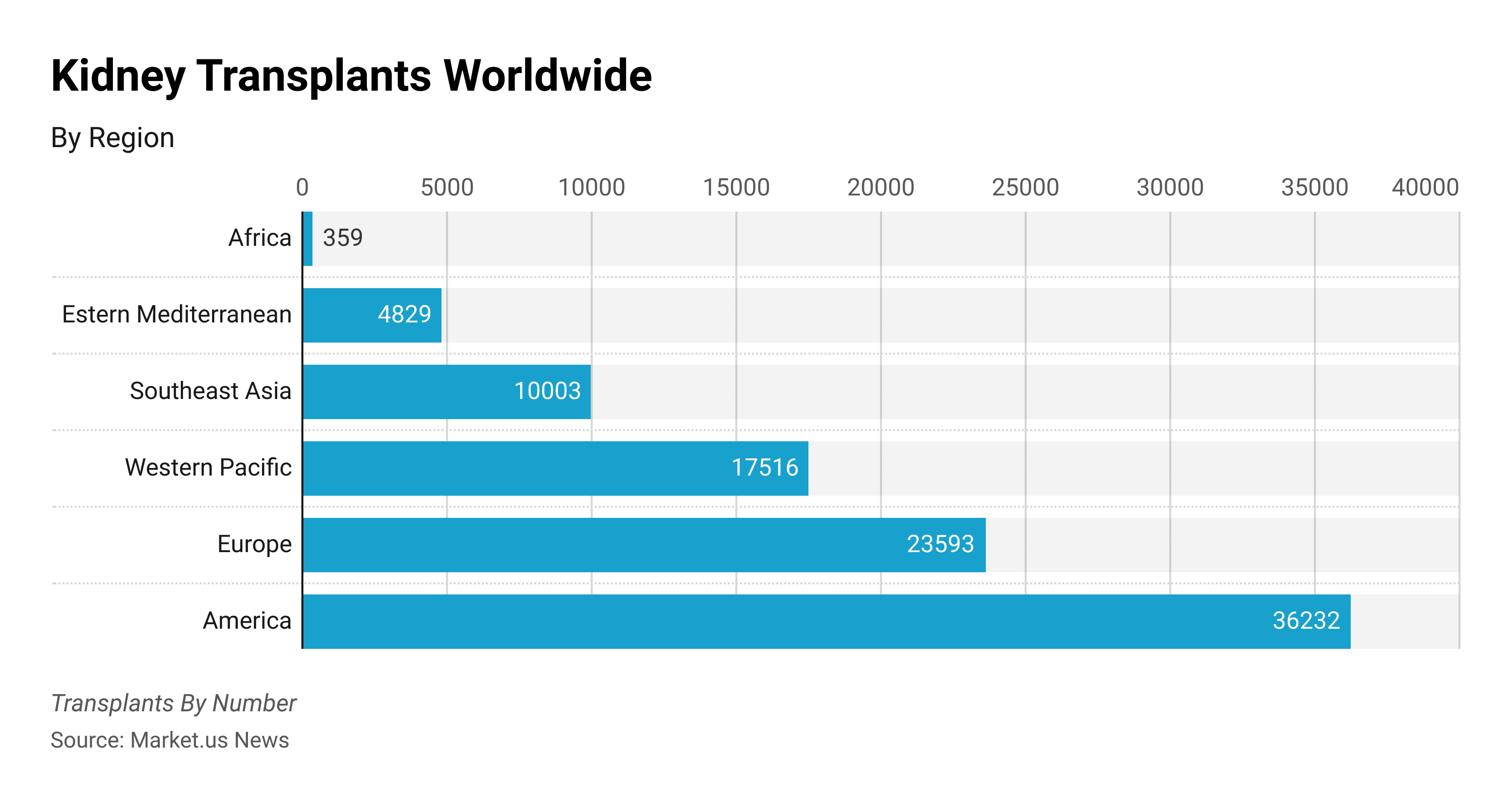
Heart Transplantation
- About 31,238 heart transplants were done in the last 10 years worldwide.
- In 2021, 513 heart transplants were pediatric, up from 423 in 2020.
- Among all donors in 2021, 206 donors were DCD donors, nearly double the amount in 2020.
- In Europe in 2021, Croatia had the highest rate of heart transplants with 8.3 per million population, followed by Slovenia with a rate of 8.1.
- In 2021, there was around one heart transplant per million populations worldwide.
(Source: UNOS, Statista)
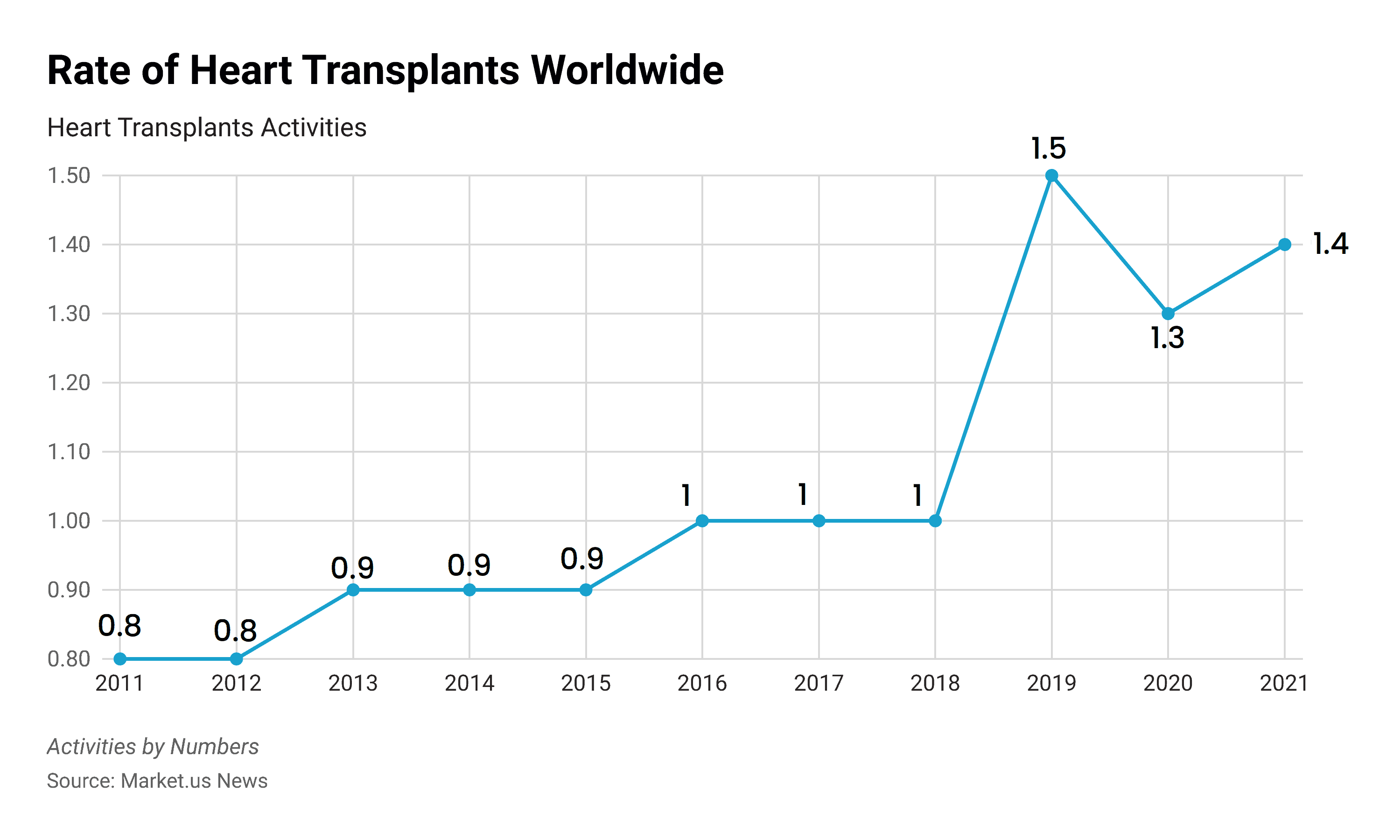
Lung Transplants
- More than 1,000 adults and children in the United States are waiting for new lungs.
- The minimum cost for a Lung Transplant in India starts from INR Rs. 12,35,000. The average price of a Lung Transplant in India is INR Rs. 17,00,000.
- The number of lung transplants has been declining since the peak noted in 2019, with 2,569 transplants occurring in 2021.
- As of November 30, 2022, the patients on the lung transplant waiting list were 289.
- About 3,096 lung transplantations were done in America in 2021 alone, while around 1,964 lung transplants were performed in the European region.
(Source: Donate Life America, practo.com, Statista)
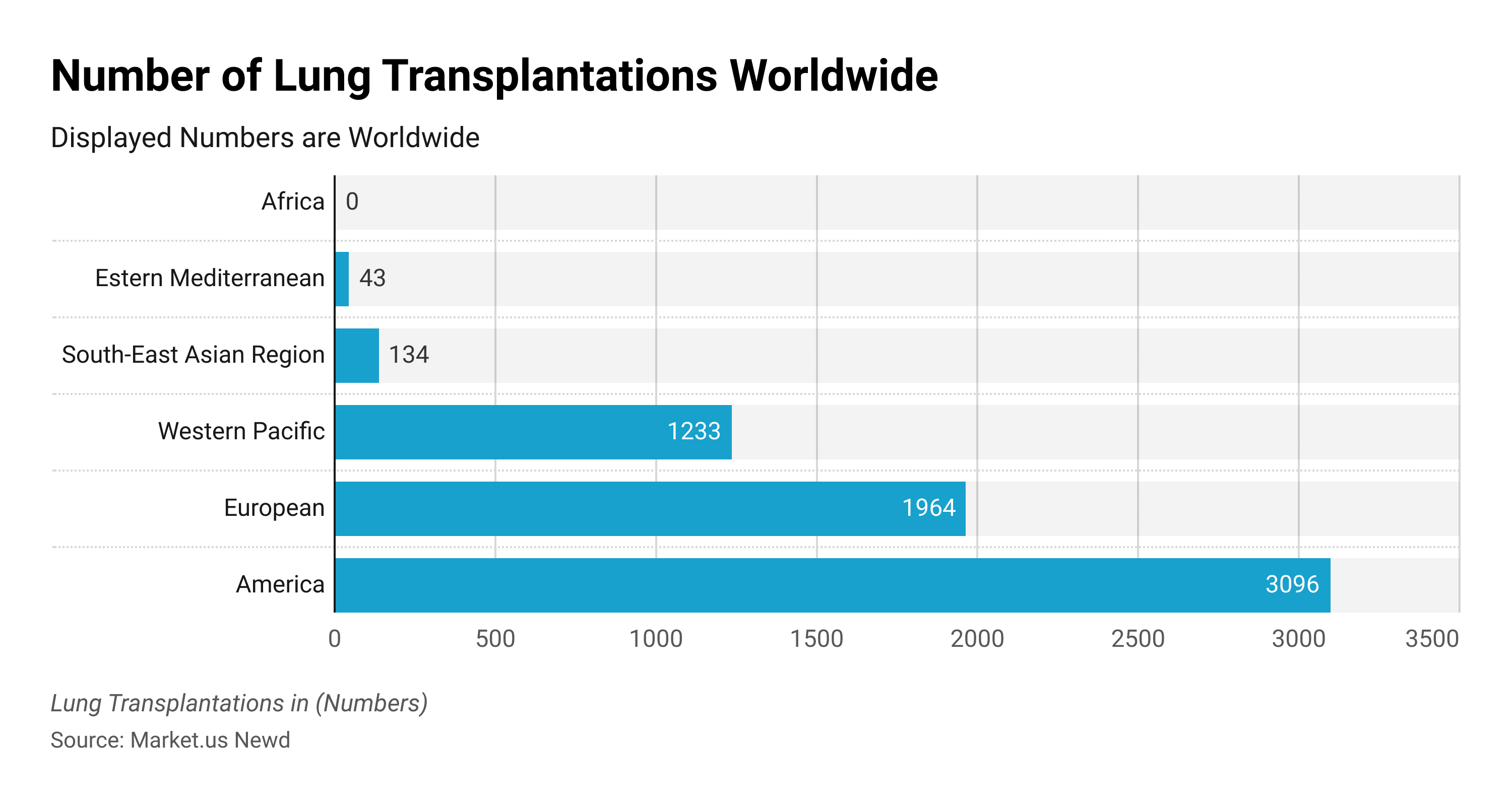
Patients Waiting List for Transplantation by Organ
- There are currently over 104,000 people on the national transplant waiting list.
- About 88,901 people were waiting for a kidney transplant in 2022, followed by patients waiting for liver transplants about 10,625.
- In 2022, 857 people were waiting for pancreas transplants, 3,365 people for heart transplants, and about 960 people were waiting for lung transplants.
- Around 2,141 people were waiting for other organ transplants in 2022.
(Source: Organ Donor)
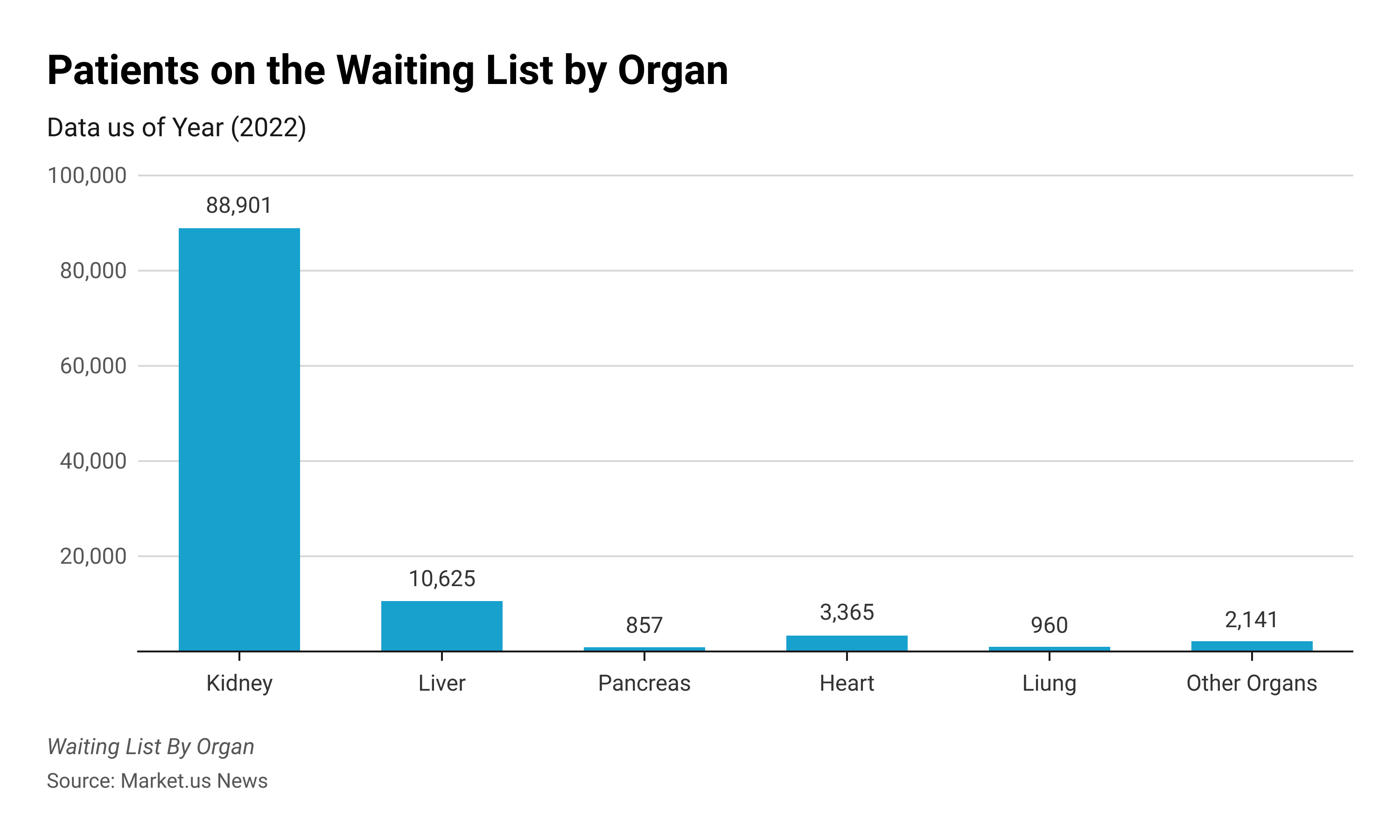
Patients Waiting List for Transplantation by Age
- People aged more than 50-64 years are more likely to wait for organ transplants. About 44,529 people are waiting for organ transplants, followed by about 26,694 people aged 65+ waiting for any organ transplant.
- 22,786 peopled aged 35-49 years are waiting for organ transplantation.
- 8,387 people aged 18-34 years are waiting for organ transplants.
- 887 people aged 11-17 years, 451 people aged 6-10 years and 634 adults aged under 5 years are waiting for organ transplants.
(Source: Organ Donor)
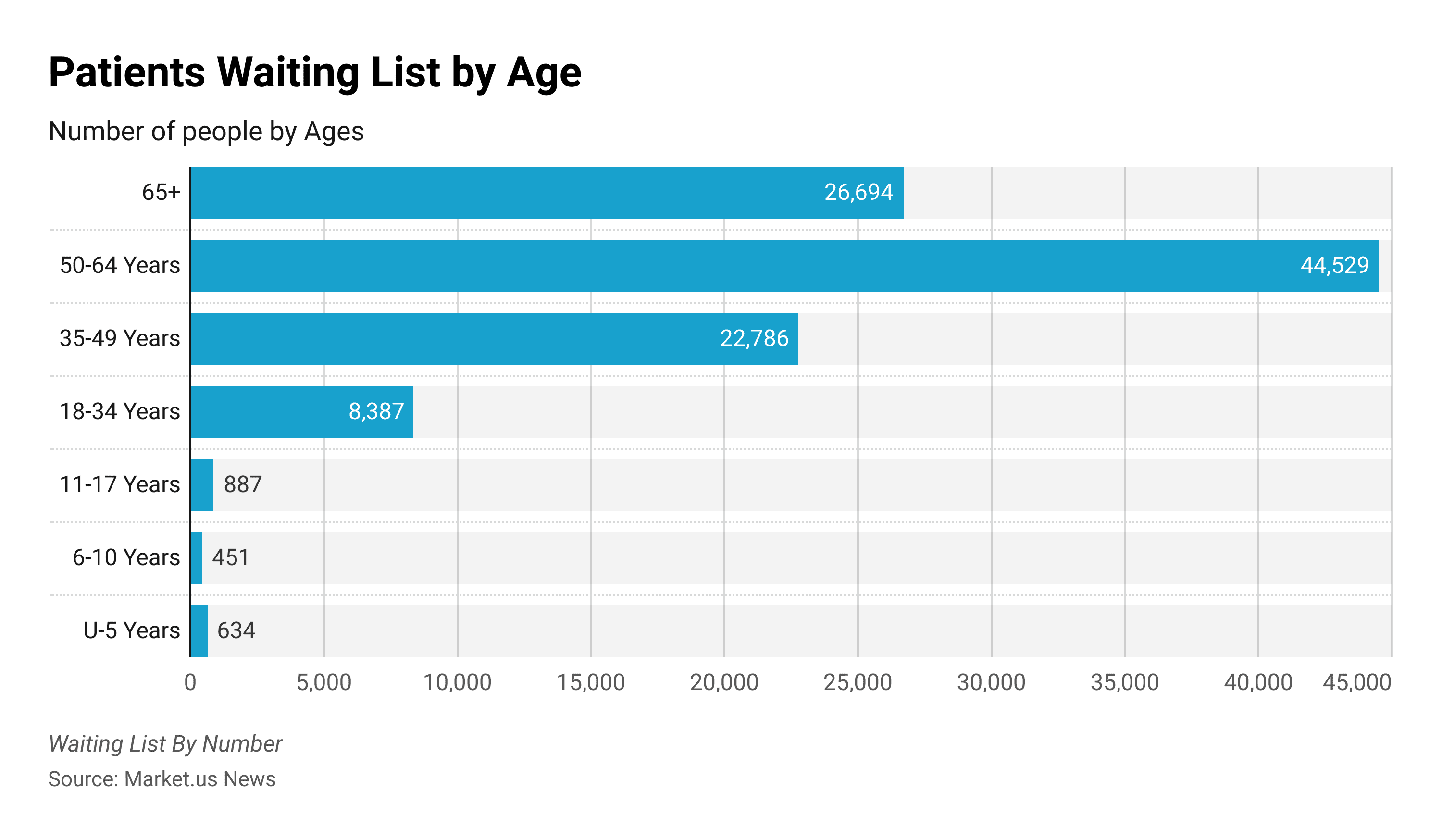
Patients Waiting List for Transplantation by Ethnicity
- White Hispanics are more likely to wait for organ transplantation (41,640), followed by black Hispanic on the waiting list at about 29,449.
- About 22,307 Hispanic/Latinos are on the waiting list for organ transplantation.
- 8,935 Asian patients are on a waiting list for organ transplantation.
- About 884 American/Alaska Natives, 592 Pacific Islanders, and 871 Multiracial patients are on the waiting list for organ transplantation.
(Source: Organ Donor)
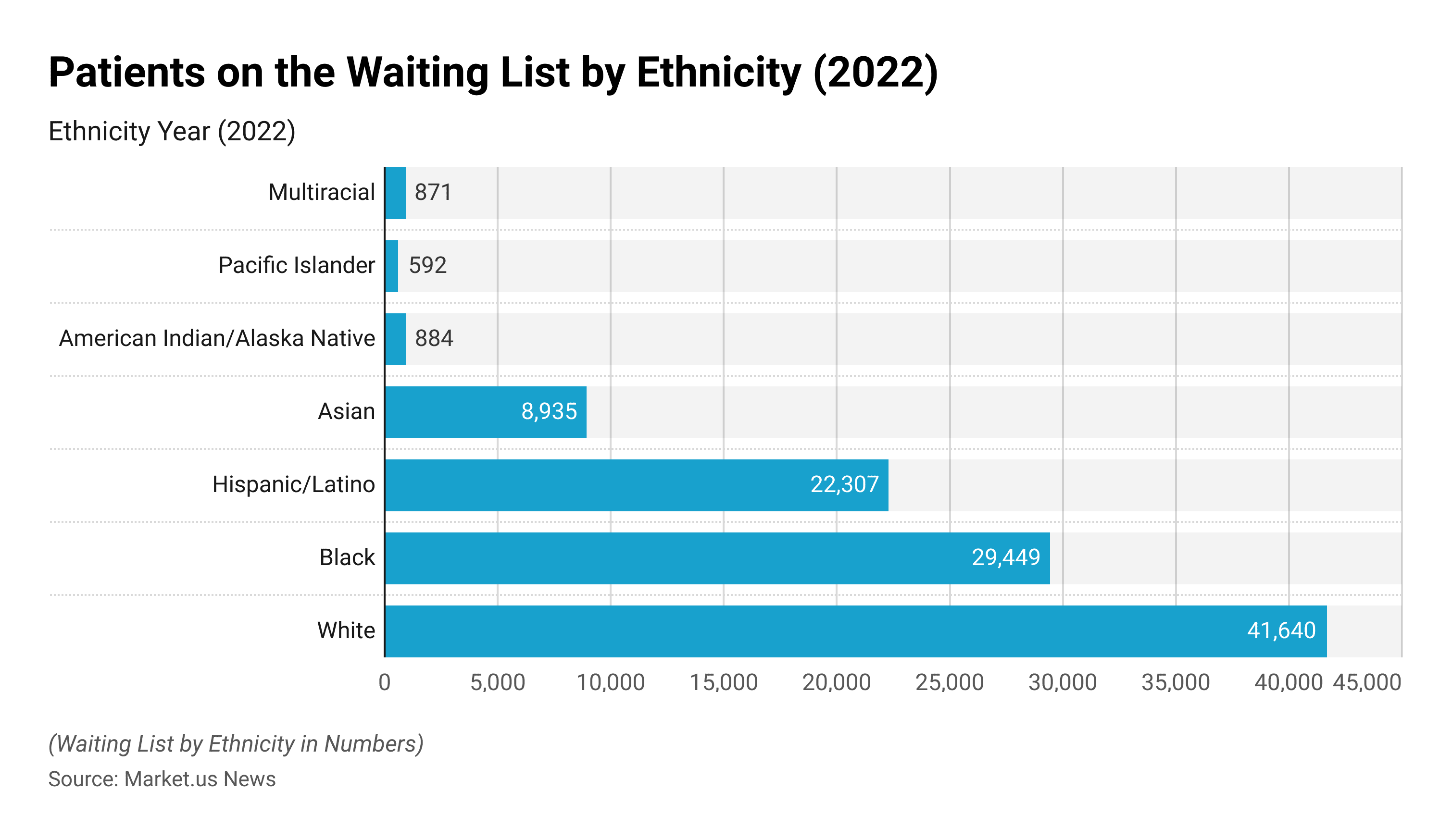
Organ Transplantation Statistics – Success Rate
- Kidney Transplants: The success rate of kidney transplantation is relatively high compared to other organ transplants. According to the Organ Procurement and Transplantation Network (OPTN) in the United States, the one-year survival rate for kidney transplants from deceased donors is around 95%, while the five-year survival rate is approximately 85-90%.
- Liver Transplants: The one-year survival rate for liver transplants from deceased donors is around 85-90%, while the five-year survival rate is approximately 70-75%.
- Heart Transplants: The one-year survival rate for heart transplants is approximately 85-90%, and the five-year survival rate is around 75-80%.
- Lung Transplants: The one-year survival rate for lung transplants is approximately 80-85%, and the five-year survival rate is around 50-55%.
- Pancreas Transplants: The success rates for combined kidney-pancreas transplants are similar to kidney transplants alone, with one-year survival rates of around 95% and five-year survival rates of 85-90%.
| Organ Transplant | One-Year Survival Rate | Five-Year Survival Rate |
| Kidney Transplants | 95% | 85-90% |
| Liver Transplants | 85-90% | 70-75% |
| Heart Transplants | 85-90% | 75-80% |
| Lung Transplants | 80-85% | 50-55% |
| Pancreas Transplants | 95% | 85-90% |
Organ Transplantation Statistics by Country
United States
The United States has one of the most advanced organ transplantation systems in the world. It has a large number of organ transplant centers and performs a significant number of transplant surgeries each year.
- According to OPTN, there were about 39,025 organ transplants performed in the United States in 2020.
- In 2020, there were 11,654 deceased donors in the U.S., resulting in a total of 23,587 transplants.
- As of 2020, there were approximately 107,000 patients on the national organ transplant waiting list in the United States.
- Generally, the one-year survival rates for most organs are quite high, ranging from 85% to 95% or even higher.
- The most common types of organ transplants performed in the U.S. include kidney, liver, heart, lung, and pancreas transplants.
- In 2021, there were 41,356 organ transplants in the United States.
- In 2021, there were just over 20,400 organ donors in the United States. Men accounted for 54% of organ donors that year.
- In the United States, just over 105,700 candidates were waiting for organ transplantation as of November 2022.
(Source: OPTN, Statista)
Number of U.S. Candidates Waiting for Organ Transplantation
- About 105,733 peoples in the united states are on waiting for organ transplants, out of them 89,977 people are waiting for kidney transplants and 10,970 for liver transplants.
- In the United States about 860 people are waiting for pancreas transplants, while about 3,375 people waiting for heart transplants.
(Source: Statista)
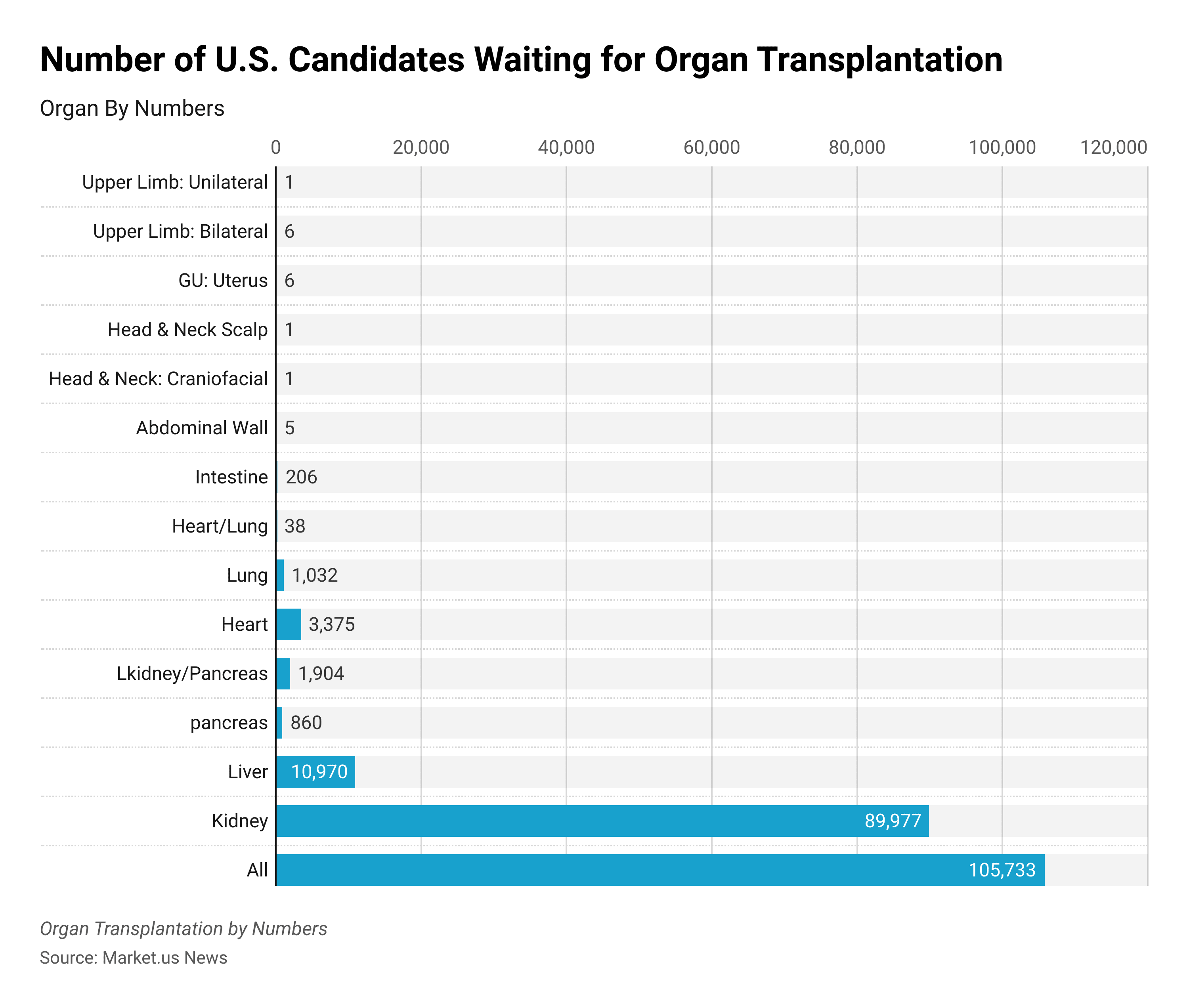
Spain
Spain is known for having one of the highest rates of organ donation in the world. It has well-organized and efficient organ transplant systems.
- Spain has an organ donation rate of 49.6 per million population (pmp) in 2021, which is relatively high than the global average of 22.9 pmp.
- In 2020, a total of 3,125 solid organ transplants were carried out in the country. This includes kidney, liver, heart, lung, and pancreas transplants.
- In 2021, Spain performed 2,221 kidney transplants. The country has a high rate of living donor kidney transplants.
- In 2022, approximately 3.4 thousand kidney transplants were performed in Spain.
- The Mediterranean country topped the European list of kidney transplantations, with a rate of 63.2 per million population in 2021.
(Source: GODT, Statista)
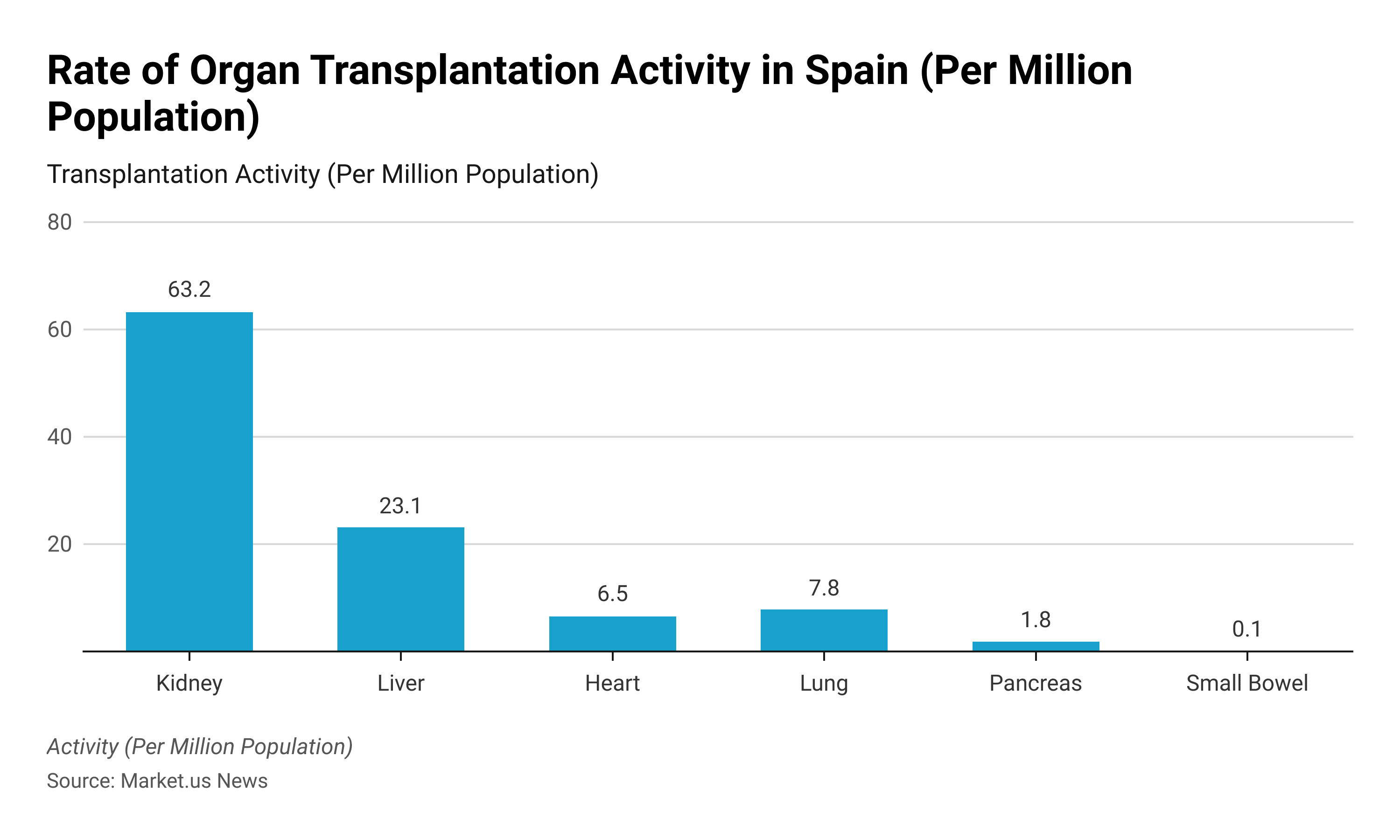
Germany
Germany is another country with a strong organ transplantation program. It has advanced medical facilities and a well-regulated system for organ allocation. Germany has achieved high success rates in organ transplants and has made significant contributions to the field.
- In 2022, a total of 4,613 organ transplants were performed in Germany including heart, lung, pancreas, and kidney.
- In Germany, according to the German Foundation for Organ Transplantation (DSO), a total of 2,905 organs were donated post-mortem in 2021, but 8,730 organs were needed for patients on the transplant list.
- In 2020, there were 2,886 kidney transplants were done in Germany.
- In 2020, there were 1,448 liver transplants performed in Germany.
- In 2020, there were 321 heart transplants were performed in Germany.
- In 2022, there were about 869 post-mortem organ donors in Germany.
(Source: DSO, Statista)
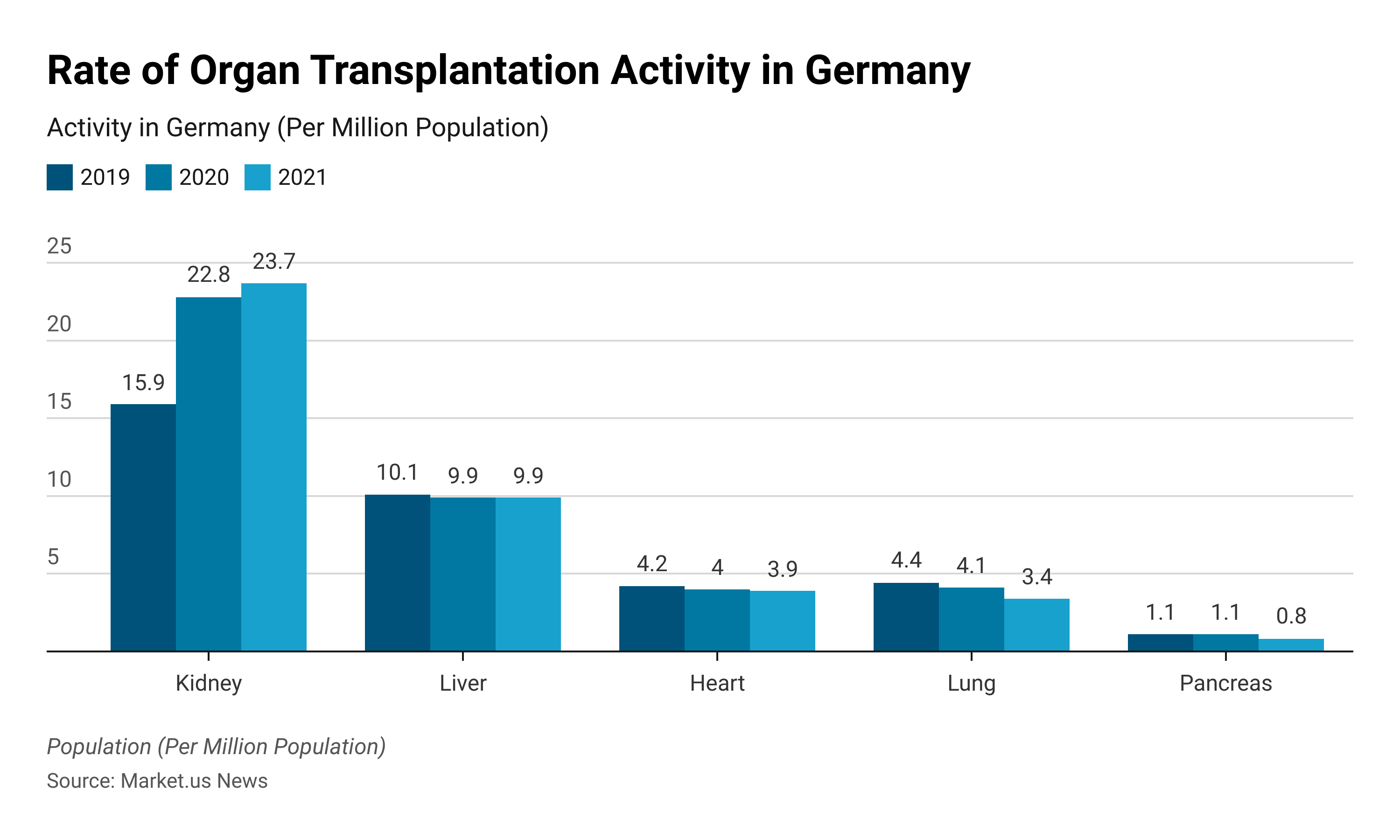
United Kingdom
- About 7,018 people in the United Kingdom are waiting for organ transplantation.
- 630 people in the UK received a transplant since April 2023.
- About 1,180 people in the UK donated their lungs in 2021.
- In 2021/2022 about 3,415 organ transplants took place in the United Kingdom.
- The majority of transplants in the UK were kidney transplants, with over 2.2 thousand transplants of this kind carried out.
(Source: Organ Donation UK, British Liver Trust, Statista)
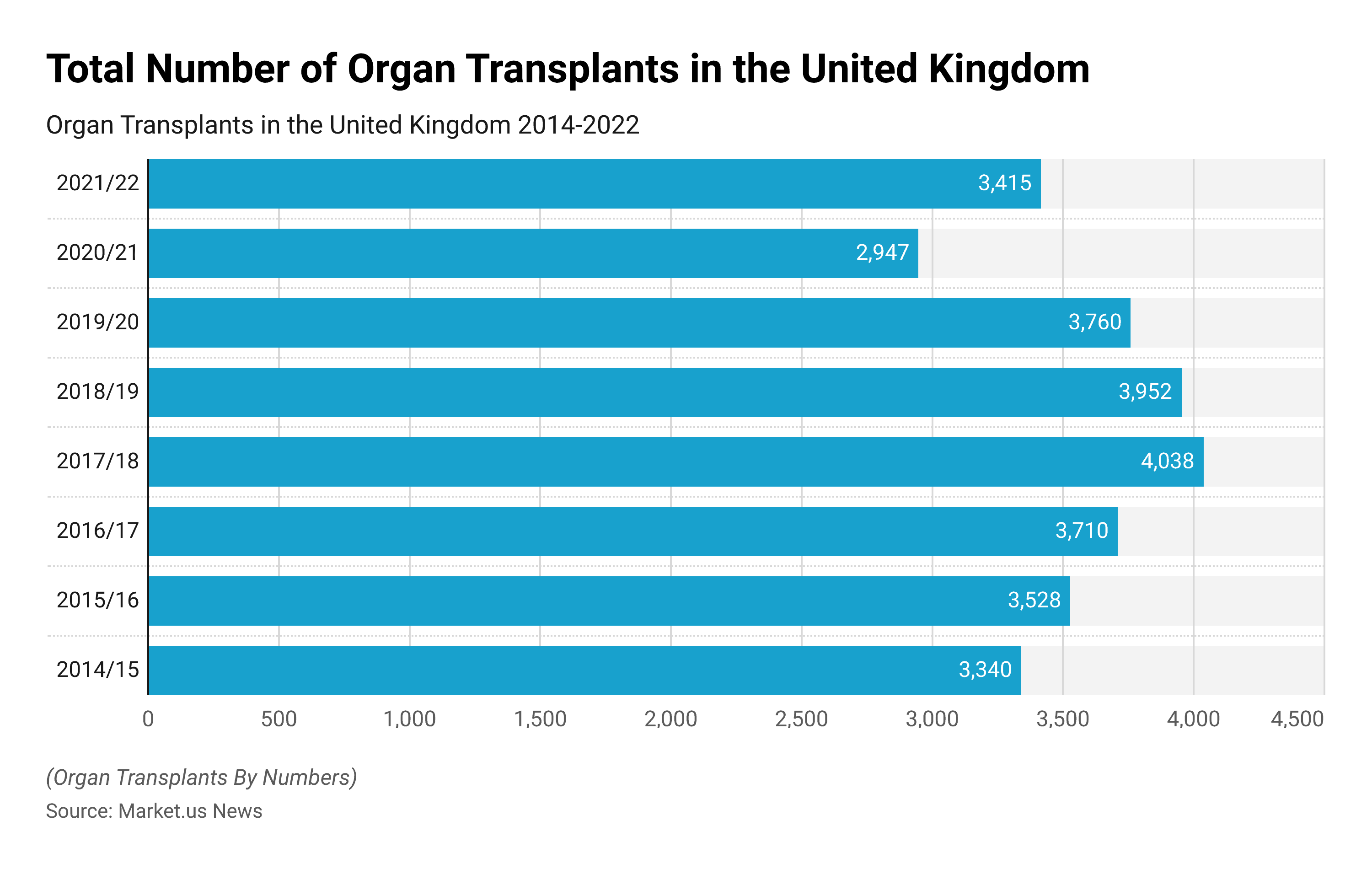
Canada
- In 2022, there were about 2,782 solid organ transplants performed in Canada.
- According to the latest available data, the deceased organ donor rate in Canada was 20.7 donors per million population (DPMP) in 2019. The living donor rate was 15.5 DPMP.
- A total of 2,782 organ transplants were performed in Canada in 2021. 78% of transplants used deceased donor organs and 21% used living donor organs.
- In 2021, a total of 652 Canadians were removed from the organ transplant waitlist. Of these, 38% had died while waiting
- In 2019, more than 4,500 Canadians were on the organ transplant waiting list.
- Canada has achieved a high success rate in organ transplantation. The one-year survival rate for kidney transplants in Canada is around 95%.
- The living donor rate in Canada in 2021 was around 15.5 donors per million people.
(Source: CIHI, CTV News)
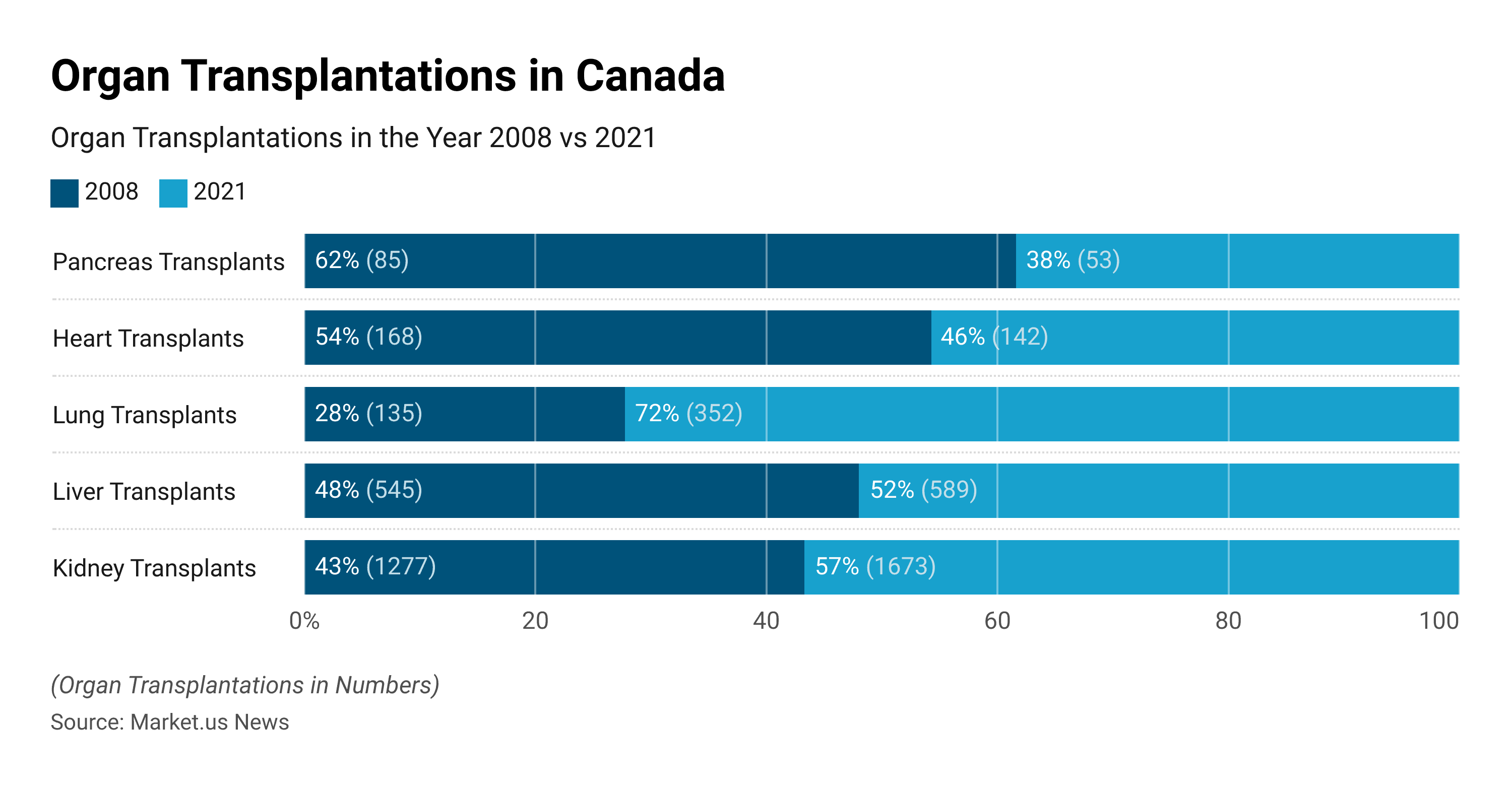
Recent Developments
Acquisitions and Mergers:
- TransplantTech acquired OrganCare Solutions for $500 million, consolidating its position in the organ transplantation market and expanding its portfolio of transplant support technologies.
- BioTransplant merged with LifeLink Organ Procurement Organization, forming a strategic partnership to optimize organ procurement and transplantation services, with combined resources facilitating increased organ transplantations and patient outcomes.
New Product Launches:
- OrganPreserve introduced a novel organ preservation solution for extended storage of donor organs, offering improved viability and transplant success rates, aiming to be utilized in 100 transplant centers within the first year.
- TransplantEase launched a mobile app for organ transplant recipients, providing personalized post-transplant care management and medication adherence support, targeting 50,000 users within six months.
Funding Rounds:
- TransplantCare received $50 million in Series A funding led by Healthcare Investment Group XYZ to expand their transplant support platform and invest in artificial intelligence algorithms for organ allocation, aiming for a 50% increase in successful transplantations within the next year.
- OrganTech secured $30 million in seed funding from Tech Investors ABC to develop innovative organ preservation techniques and establish partnerships with transplant centers, targeting a 40% growth in transplant procedures over the next fiscal year.
Organ Donation Trends:
- Despite challenges posed by the COVID-19 pandemic, organ donation rates remained stable, with a slight increase in deceased organ donors compared to the previous year.
- Living organ donation continued to rise, with a 10% increase in living kidney and liver donations facilitated by advances in minimally invasive surgical techniques and donor advocacy initiatives.
Regulatory Landscape:
- Regulatory agencies implemented guidelines for organ procurement and transplantation practices, ensuring adherence to ethical standards and patient safety in organ transplantation procedures.
Investment in Research and Development:
- Healthcare organizations and transplant centers allocated significant resources to research and development in organ preservation and transplantation techniques, with an estimated $2.5 billion invested globally in organ transplantation advancements and market expansion initiatives.
Conclusion
Organ Transplantation Statistics – Organ transplantation plays an important role in saving and improving the lives of patients with organ failure.
Countries like the United States, Spain, Germany, the United Kingdom, and Canada gained success rates in organ transplantations.
The impact of organ transplantation extends far beyond the physical aspect. It provides hope to patients and their families, offering them a chance at a renewed life.
With continued efforts, organ transplantation can save more lives and improve the well-being of countless individuals in need.
FAQs
Organ transplantation is a surgical procedure in which a healthy organ or tissue is removed from a donor and transplanted into a recipient who has a damaged or failing organ. The most common organs transplanted include the heart, liver, kidney, lungs, and pancreas.
Organ transplantation is a major surgery and carries risks, such as infection, bleeding, organ rejection, and side effects from immunosuppressant medications. The risks vary depending on the specific organ being transplanted and the individual’s overall health.
Discuss your needs with our analyst
Please share your requirements with more details so our analyst can check if they can solve your problem(s)



